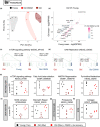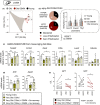Multi-omic rejuvenation of naturally aged tissues by a single cycle of transient reprogramming
- PMID: 35235716
- PMCID: PMC8920440
- DOI: 10.1111/acel.13578
Multi-omic rejuvenation of naturally aged tissues by a single cycle of transient reprogramming
Abstract
The expression of the pluripotency factors OCT4, SOX2, KLF4, and MYC (OSKM) can convert somatic differentiated cells into pluripotent stem cells in a process known as reprogramming. Notably, partial and reversible reprogramming does not change cell identity but can reverse markers of aging in cells, improve the capacity of aged mice to repair tissue injuries, and extend longevity in progeroid mice. However, little is known about the mechanisms involved. Here, we have studied changes in the DNA methylome, transcriptome, and metabolome in naturally aged mice subject to a single period of transient OSKM expression. We found that this is sufficient to reverse DNA methylation changes that occur upon aging in the pancreas, liver, spleen, and blood. Similarly, we observed reversion of transcriptional changes, especially regarding biological processes known to change during aging. Finally, some serum metabolites and biomarkers altered with aging were also restored to young levels upon transient reprogramming. These observations indicate that a single period of OSKM expression can drive epigenetic, transcriptomic, and metabolomic changes toward a younger configuration in multiple tissues and in the serum.
Keywords: OSKM; Yamanaka; aging; epigenetic clocks; pluripotency; reprogramming; transcriptomic clocks.
© 2022 The Authors. Aging Cell published by Anatomical Society and John Wiley & Sons Ltd.
Conflict of interest statement
D.E.M.H is a founder and shareholder at Chronomics Limited. G.K. is founder of Samsara Therapeutics and advisor of The Longevity Labs. W.R. is consultant and shareholder of Cambridge Epigenetix. M.S. is founder, shareholder, and advisor of Senolytic Therapeutics, Inc., Iduna Therapeutics, Inc, and Rejuveron Senescence Therapeutics, AG. The funders had no role in study design, data collection and analysis, decision to publish, or preparation of the manuscript.
Figures





References
-
- Abad, M. , Mosteiro, L. , Pantoja, C. , Cañamero, M. , Rayon, T. , Ors, I. , Graña, O. , Megías, D. , Domínguez, O. , Martínez, D. , Manzanares, M. , Ortega, S. , & Serrano, M. (2013). Reprogramming in vivo produces teratomas and iPS cells with totipotency features. Nature, 502(7471), 340–345. 10.1038/nature12586 - DOI - PubMed
-
- Bates, D. , Mächler, M. , Bolker, B. M. , & Walker, S. C. (2015). Fitting linear mixed‐effects models using lme4. Journal of Statistical Software, 67(1), 1–48. 10.18637/jss.v067.i01 - DOI
-
- Carlson, M. (2019). R packakge: Bioconductor ‐ Org.Hs.eg.DB. 10.18129/B9.bioc.org.Hs.eg.db - DOI
Publication types
MeSH terms
Associated data
- Actions
Grants and funding
LinkOut - more resources
Full Text Sources
Other Literature Sources
Molecular Biology Databases

